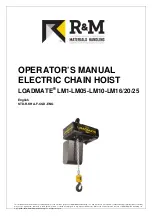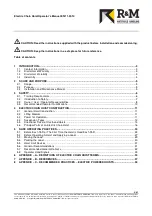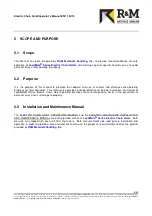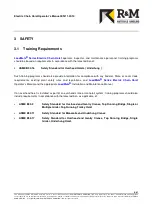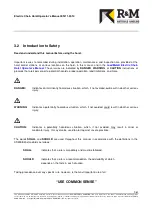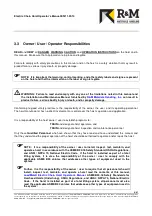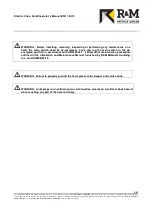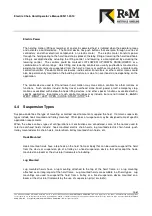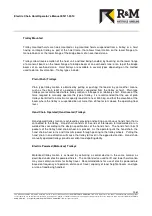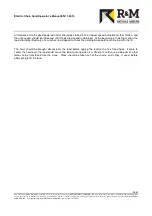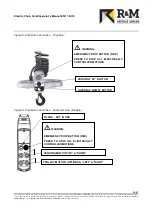
Electric Chain Hoist Operator’s Manual/EN/11.30.10
14/41
This document and the information contained herein, is the exclusive property of R&M MATERIALS HANDLING, INC. and represents a non-public, confidential and proprietary trade
secret that may not be reproduced, disclosed to third parties, altered or otherwise employed in any manner whatsoever without the express written consent of R&M MATERIALS
HANDLING, INC. . Copyright © (2010) R&M MATERIALS HANDLING, INC. . All rights reserved.
4.5 Directional Travel of Overhead Hoists
Hoist motion is the vertical travel motion direction of the hoist load hook. The hoist operator should be familiar
with the hoist (or crane) controls and understand what type of motion will occur when any one of the control
devices is activated. The controls
SHALL
be marked, and all markings
SHALL
be legible. The daily inspection
that is required to be performed by the operator at the start of each shift or at the time the hoist is first used
during each shift,
SHOULD
include a check that all motions agree with control device markings.
Overhead hoists have one axis of directional travel. This is:
THE HOISTING OR VERTICAL TRAVEL DIRECTION OF THE LOAD HOOK
When overhead hoists are trolley suspended, the trolley hoist unit has two axes of directional travel. These
include:
THE HOISTING OR VERTICAL TRAVEL DIRECTION OF THE LOAD HOOK
THE TRAVERSE TRAVEL DIRECTION OF THE TROLLEY (INCLUDING THE HOIST UNIT)
When trolley suspended overhead hoists are used on an overhead crane, the crane, including the trolley hoist
unit has three axes of directional travel. These include:
THE HOISTING OR VERTICAL TRAVEL DIRECTION OF THE LOAD HOOK
THE TRAVERSE TRAVEL DIRECTION OF THE TROLLEY (INCLUDING THE HOIST UNIT)
•
THE TRAVERSE TRAVEL DIRECTION OF THE BRIDGE (INCLUDING THE TROLLEY AND HOIST
UNIT)
Some hoists or cranes may have power-operated rotating hooks, power-operated below-the-hook lifting devices,
or other power-operated accessories that result in additional axes of directional travel.
If more than one hoist or trolley hoist unit is used on an overhead crane, each hoist or trolley hoist
SHALL
have
an identification mark on it or its load block, and these markings
SHALL
also appear on the controllers used by
the operator.
For example, if a crane has two trolley hoist units, one trolley hoist unit shall be marked “1” (or some other
designation) on the trolley hoist or load block, and the other trolley hoist unit shall be marked “2” (or some other
designation) on the trolley hoist or load block.
The markings on the trolley hoists are to be visible to the operator and any signal person used in rigging the
load. The controllers for trolley hoist 1 must be marked “1” (or other designation used on the trolley hoist), and
the controllers for trolley hoist 2 must be marked “2” (or other designation used on the trolley hoist).

